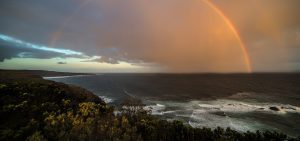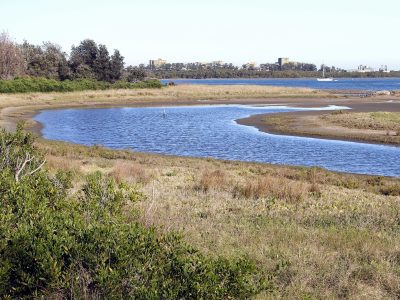Public Trust Doctrine Part 1: Tribute to Jim Titus
Last week I received an email from Jim Titus informing a group of us that this was his last day at the US Environmental Protection Agency (EPA). I quickly responded with congratulations on a great public service career, and he came back immediately to say that I was the last to use his EPA email address as he was on a train about to turn in his badge. So, who is Jim Titus and why am I so impressed with his contributions to coastal management?
Jim Titus is one of my coastal heroes. He is the classic long-term technical public servant who since the early 1980s served in the EPA as a climate change expert interested in coastal problems. I have noted over the years how the federal public service in the US often retains professional staff with a high level of expertise in the major agencies like NOAA and EPA. They stay in their jobs through cycles of administration that can be sympathetic or antagonistic to climate change science. The remarkable James Hansen from NASA is one such person. Jim is another.
I first heard of Jim’s research on sea-level change in the mid-1980s. In 1983 he was a member of a team at the EPA that began releasing “alerts” of the threats posed to occupants along the US east coast associated with the “Greenhouse effect”. In 1989 as part of a review I undertook for the Prime Minister’s Science Council, I used a figure from an EPA report by Hoffman, Keyes and Titus that showed various projections of global sea level to 2100. This was followed by a range of publications that highlighted the challenges of living in low-lying areas (for instance, Titus 1990, in Coastal Management (18, 65-90) on the “Greenhouse effect, sea-level rise, and barrier islands: case study of Long Beach Island, New Jersey”).
These early studies set in place a career working with teams inside and outside the EPA on mapping areas vulnerable to sea level rise along Atlantic and Gulf coasts. Most remarkable is the comprehensive, multi-authored synthesis and assessment report of 2009 presented to Congress and US President on Coastal Sensitivity to Sea-Level Rise: A focus on the Mid-Atlantic Region. Jim served as the Coordinating Lead Author of this 298-page report.
Jim’s background is in social science interested in matters related to economics, land use planning and law. He has been able to collaborate with coastal scientists and build on the studies of others as the sea-level rise expert within the EPA. But it has not been without difficulties. A report in the New York Times on 20 June 2006 referred to him as a “censured expert”. This was during the years of President Bush when climate change issues were highly politicized. The arrival of President Obama allowed more freedom for the EPA staff to publish and the 2009 report mentioned above was one outcome. Life became more constrained in so many ways for the EPA during the President Trump period. His frustrations over time led him to set up his own web site www.risingsea.net. As stated on this site here “we will also provide information that you will not find on government web sites”. It is very pleasing to see that “freedom” to publish has returned; Jim’s most recent work has just appeared in Environmental Research Letters (February 2023, 18 (3)) on “Populations in floodplains or close to sea level increased in the US but declined in some counties—especially among Black residents”.
In 1998 as a result of dissertation research, Jim published one of the most inspiring journal papers I have ever read: “Rising seas, coastal erosion, and the takings clause: how to save wetlands and beaches without hurting property owners” (Maryland Law Review, 1998, 57, 4, 1279-1399). In many respects it changed my way of thinking about coastal management. It is a monumental piece of scholarship with its 494 footnotes alone providing extra text that had to be read! He initially posed the question “Shall we give away the shore? This leads into analysis of policies and options to protect natural shores, the dreaded issue of compensation, whether property owners have rights to eliminate wetlands and beaches in their own interest, and onto alternatives including one that he has advocated many times since that of “rolling easements”. I got excited enough to run a postgraduate short course based on this article. Poor students. It was necessary to divide the class in order that all six sections could be explored. It was something you can only try once! But it was for me a great opportunity to learn and try to communicate the ideas that were so powerfully communicated in this article. It led me to invite Jim to Australia in 2000 and we drove from Sydney to Yamba to the NSW Coastal Conference talking the entire time! He was quite a hit. In 2013 I met up with him in Washington and we toured coastal Maryland together.
Section IV of the 1998 paper exposed me to the Public Trust Doctrine (PTD). It deals with a common law right that has intrigued me ever since. Whenever I can I seek to advocate its relevance to Australia. I will explore this point further in the next blog. But here I will cite Titus (1998, 1362-1364) on how he introduced his readers to the evolution of the PTD.
He referred to a waterfront property owner in New Jersey who in 1820 sought to prevent a shellfish collector from being on mudflats on what he saw as his property. The collector argued that the “mudflats were incapable of ownership”. The New Jersey Supreme Court in reviewing ancient and common law concluded “that before the American revolution the King had no authority to grant ownership of tidelands to private individuals” . In doing so the court recognised a doctrine that since the sixth century Roman times had given the public certain rights, “common to all citizens”, to the “…bays, the coasts of the sea, including both the water and the land under the water”. This was the essence of the PTD. In the following decades the US Supreme Court stated that all thirteen original states followed the PTD and subsequent states were also granted submerged lands upon statehood. This confirmed preexisting arrangements settled since the Magna Carta in England that the King had no power to sell public trust lands although as we will find out this can be qualified if the legislature has the direct intent to do so.
What I plan to do in my next blog is address the question: can the Commonwealth Government enact provisions of the PTD in such a way to guide state and territory governments to a more strategic approach in addressing impacts of rising seas and loss of land claimed as privately owned?
Bruce Thom
Words by Prof Bruce Thom. Please respect the author’s thoughts and reference appropriately: (c) ACS, 2023. For correspondence about this blog post please email admin@australiancoastalsociety.org.au
#235



 Coastal Adaptation in Aotearoa New Zealand
Coastal Adaptation in Aotearoa New Zealand